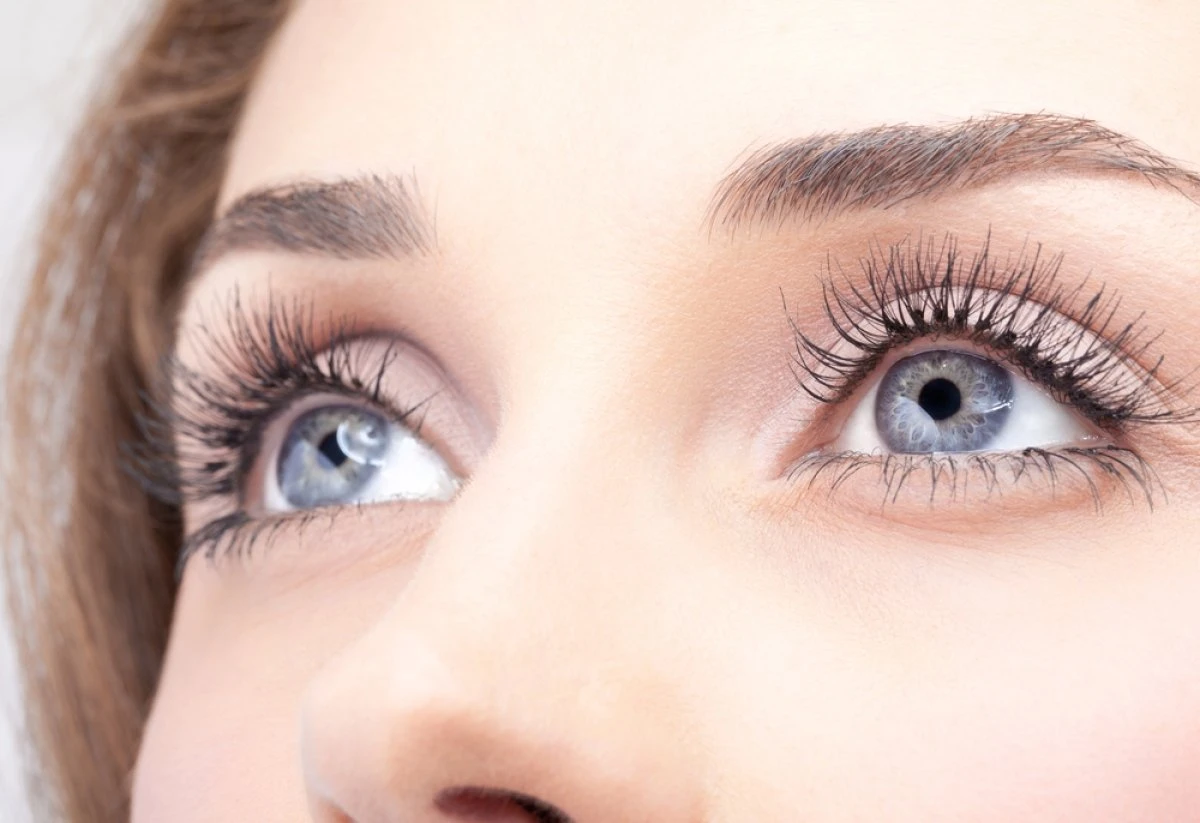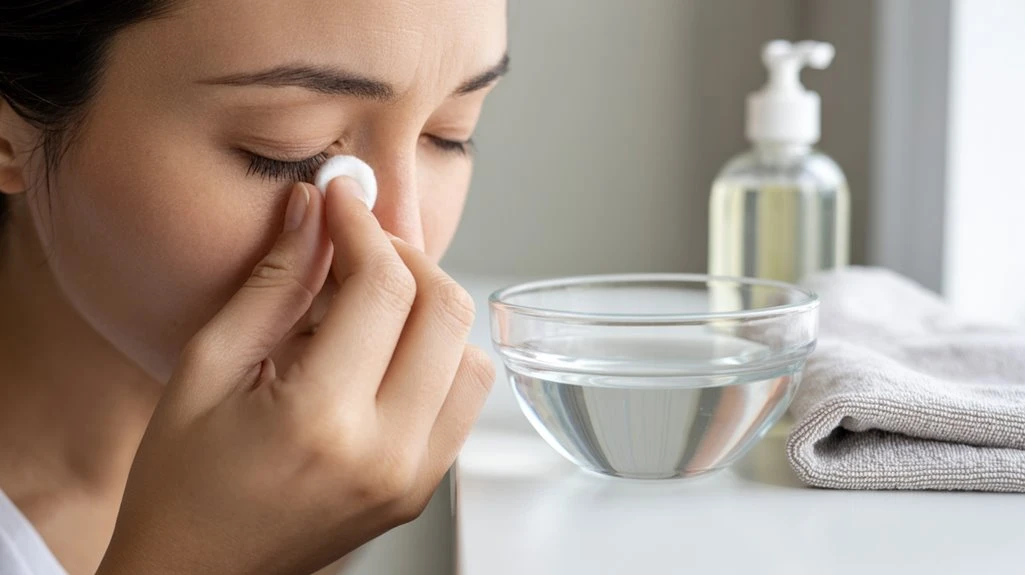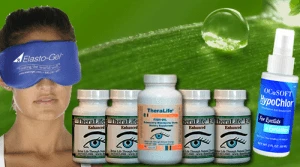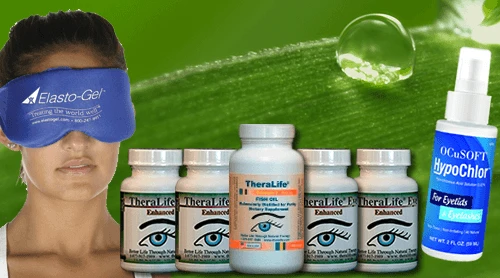To treat blepharitis at home, you can start by applying warm compresses to your closed eyelids for 5–10 minutes to help loosen debris and soften oils. This is followed by gently cleansing the eyelid margins with a sterile pad or diluted cleanser and massaging the lids to promote meibomian gland function. Using TheraLIfe Eye capsules can provide lubrication, and if Demodex mites are suspected, diluted tea tree oil may be helpful.
For more comprehensive care, consider TheraLife’s unique oral eye treatment products, which offer an innovative approach to managing blepharitis. TheraLife is the only company that provides oral treatment specifically designed for eye care, helping to control symptoms and reduce recurrence. Incorporating these steps and TheraLife products into your daily routine can enhance your eye health and comfort.
Best Oral Treatment from TheraLife
Add To Cart
Key Takeaways
- Apply warm compresses to closed eyelids for 5–10 minutes daily to loosen crusts and soften oil secretions.
- Gently cleanse eyelid margins with a diluted, preservative-free cleanser or baby shampoo using a sterile cotton swab.
- Perform gentle eyelid massage after compresses to promote meibomian gland secretion and reduce blockage.
- Use preservative-free artificial tears to relieve irritation and maintain ocular surface hydration.
- Maintain consistent eyelid hygiene and replace eye makeup regularly to prevent future flare-ups.
Understanding the Causes and Symptoms of Blepharitis

Blepharitis, a common inflammatory condition affecting the eyelid margins, often develops due to several underlying factors such as bacterial colonization, seborrheic dermatitis, or dysfunction of the meibomian glands. When you experience this condition, the primary causes of blepharitis include overgrowth of Staphylococcus bacteria, abnormal oil production, or associated skin disorders. These pathophysiological changes disrupt the homeostasis of the eyelid margin, leading to characteristic symptoms of blepharitis. You’ll likely notice eyelid redness, swelling, irritation, and crusting at the lash line. Other symptoms include burning, foreign body sensation, photophobia, and excessive tearing. Chronic cases may present with madarosis, trichiasis, or conjunctival inflammation. Regular eyelid hygiene is crucial to minimize symptom recurrence and manage blepharitis effectively. Recognizing the causes of blepharitis and its symptoms is essential for timely diagnosis, appropriate management, and minimizing complications.
Daily Eyelid Hygiene Routine
Although consistent management is essential to control symptoms, establishing a daily eyelid hygiene routine remains the cornerstone of at-home treatment for blepharitis.
Begin by applying warm compresses to your closed eyelids for 5–10 minutes. This step loosens crusts and softens meibum, facilitating subsequent cleaning and reducing gland obstruction.
After removing the compress, use a lint-free pad or sterile cotton swab moistened with diluted, preservative-free cleansing solution to gently wipe along the eyelid margins. This removes debris and biofilm that contribute to chronic inflammation.
Incorporate eyelid massage by using clean fingertips to apply gentle pressure along the eyelids, promoting meibomian gland secretion and improving tear film stability.
Hypochlorous acid solutions are recommended as they are effective against microbial agents, enhancing the efficacy of your eyelid hygiene routine.
Perform this hygiene regimen at least once daily, or as recommended by your ophthalmologist, to optimize symptom control and prevent recurrence.
Effective Home Remedies for Relief
When you’re managing blepharitis at home, several evidence-based remedies can provide symptomatic relief and support ongoing eyelid health.
Utilizing home approaches can reduce inflammation, improve tear film stability, and decrease bacterial load. Consistent application of these therapies is essential for ideal outcomes.
Consider incorporating the following interventions:
- Apply warm compresses to your closed eyelids for 5–10 minutes, enhancing meibomian gland function and liquefying meibum.
- Perform gentle eyelid massage after compresses to facilitate gland secretion and decrease stasis.
- Cleanse eyelid margins using commercially available lid cleanser, Avenova.
- Use natural oils, such as tea tree oil (appropriately diluted), to address Demodex infestation, which is often implicated in chronic cases.
- Maintain ocular surface hydration with preservative-free artificial tears to alleviate irritation and dryness.
- Incorporating Omega-3 fatty acids into your diet can support tear production and reduce inflammation, complementing these home remedies for blepharitis.
Adhere to these remedies consistently for effective relief.
When to Use Over-the-Counter Treatments
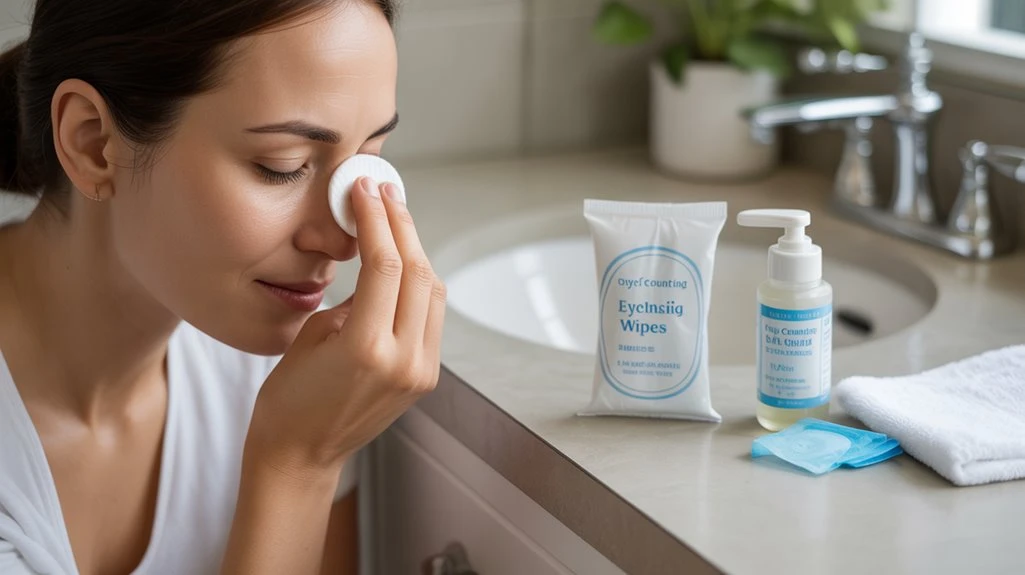
Occasionally, home remedies may not provide sufficient control of blepharitis symptoms, prompting the need for over-the-counter (OTC) treatments. If you continue to experience eyelid irritation, crusting, or persistent redness despite diligent hygiene, you should consider OTC medications to enhance treatment effectiveness. Pharmacologic options such as artificial tears, eyelid cleansing wipes, and topical antibiotic ointments can target inflammation, bacterial overgrowth, and discomfort. These interventions are accessible without a prescription and offer evidence-based support for symptom relief. While home remedies can provide some relief, they may lack the extensive research backing that specialized products like Theralife have.
Here’s a comparison of common OTC options:
| Product Type | Mechanism of Action | Typical Use |
|---|---|---|
| Artificial Tears | Lubricates ocular surface | Dryness, irritation |
| Eyelid Cleansing Wipes | Removes debris, bacteria | Daily lid hygiene |
| Antibiotic Ointment | Reduces microbial load | Persistent irritation |
Evaluate symptom persistence to determine if OTC treatments are warranted.
Tips for Preventing Future Flare-Ups
Consistent eyelid hygiene forms the cornerstone of preventing blepharitis flare-ups, as it minimizes microbial colonization and sebaceous gland obstruction. You’ll need to integrate evidence-based strategies into your daily routine to reduce recurrence risk. Lifestyle adjustments, such as managing environmental allergens and reducing contact lens wear during active symptoms, can be highly effective. Dietary considerations, particularly increasing intake of omega-3 fatty acids, may improve meibomian gland function. Warm compresses not only relieve symptoms but also improve meibomian gland function by enhancing oil flow necessary for a healthy tear film. Consider these practical, clinically recommended measures:
- Perform daily lid scrubs using a sterile, non-irritating cleanser
- Apply warm compresses for 5–10 minutes to promote glandular secretion
- Avoid cosmetic products that may exacerbate eyelid irritation
- Replace eye makeup regularly to prevent bacterial contamination
- Incorporate omega-3-rich foods (like flaxseed or fish oil) to support ocular surface health
Implementing these steps helps maintain remission and prevent future episodes.
Best Oral Treatment from TheraLife
Add To Cart
Frequently Asked Questions
Can Blepharitis Cause Permanent Vision Loss?
You’re right to be concerned about permanent effects from blepharitis.
While this chronic eyelid inflammation rarely leads to permanent vision loss, you shouldn’t ignore it. Severe or untreated cases can cause complications like corneal ulceration or scarring, which carry vision implications.
Most patients experience irritation, burning, or blurred vision, but with proper management, these symptoms usually resolve without lasting damage.
Consistent treatment greatly reduces your risk of any permanent vision changes.
Is Blepharitis Contagious to Others?
Think of blepharitis as a storm brewing quietly on your eyelids—fortunately, it’s not contagious. You can’t pass it to others through casual contact.
Blepharitis symptoms, like redness, crusting, or irritation, usually result from inflammation due to bacteria or skin conditions, not from transmissible pathogens.
For blepharitis prevention, focus on meticulous eyelid hygiene and prompt treatment of underlying causes. Maintaining this regimen helps control flare-ups and reduces the risk of recurrent symptoms.
Can Children Develop Blepharitis?
Yes, children can develop blepharitis.
You may notice children symptoms such as eyelid redness, crusting, irritation, and sometimes a burning sensation.
Early recognition is essential, as untreated blepharitis can lead to recurrent conjunctivitis or chalazia.
Evidence-based blepharitis treatment for children includes consistent eyelid hygiene, application of warm compresses, and, in some cases, topical antibiotic or anti-inflammatory agents.
Always consult a pediatric ophthalmologist to guarantee the most appropriate management for your child.
Are There Any Dietary Changes That Help Blepharitis?
You can support blepharitis management by incorporating specific dietary changes.
Evidence suggests that dietary supplements like omega-3 fatty acids may help reduce eyelid inflammation. Including anti-inflammatory foods—such as fatty fish, flaxseed, and leafy greens—can modulate the inflammatory response associated with blepharitis.
While these interventions aren’t a substitute for medical therapy, clinical studies indicate they may improve symptoms and enhance tear film stability.
Always consult your ophthalmologist before starting new supplements.
Does Blepharitis Affect Contact Lens Wearers Differently?
If you wear contact lenses, blepharitis can cause increased discomfort, blurred vision, and a higher risk of lens intolerance or infection.
It’s essential to maintain strict contact lens hygiene, including thorough cleaning and regular lens replacement.
Treatment options for blepharitis—such as lid scrubs, warm compresses, and prescribed medications—should be diligently followed.
Evidence shows that managing eyelid inflammation improves contact lens tolerance and reduces the risk of complications like microbial keratitis or conjunctivitis.
Best Oral Treatment from TheraLife
Add To Cart
Conclusion
Blepharitis can be a stubborn condition, but with the right approach, relief is within reach. Theralife.com stands out for its unique offerings, providing the only oral eye treatment care available on the market. Their products are designed to help manage chronic eye discomfort effectively, transforming persistent symptoms into manageable eye health.
Theralife’s comprehensive approach not only targets blepharitis but also addresses related conditions such as dry eyes, uveitis, and Sjogren’s syndrome. By incorporating Theralife’s evidence-based strategies, you can experience the benefits of improved eye health and comfort. Their trusted solutions are rooted in natural healing, offering a proactive path to recovery.
For those dealing with blepharitis, consistent eyelid hygiene, combined with Theralife’s innovative oral treatments, can disrupt bacterial overgrowth and soothe irritation. It’s important to heed medical advice to avoid complications, but with Theralife’s products, you’re empowered to take control of your eye health. By maintaining vigilance and prevention, Theralife helps you keep blepharitis at bay, ensuring your eyes remain healthy and comfortable.
References
- 1.
- Putnam CM. Diagnosis and management of blepharitis: an optometrist’s perspective. Clin Optom (Auckl). 2016;8:71-78. [PMC free article] [PubMed]
- 2.
- Huggins AB, Carrasco JR, Eagle RC. MEN 2B masquerading as chronic blepharitis and euryblepharon. Orbit. 2019 Dec;38(6):514-518. [PubMed]
- 3.
- Dietrich-Ntoukas T. [Chronic Blepharitis]. Klin Monbl Augenheilkd. 2022 Nov;239(11):1381-1393. [PubMed]
- 4.
- Rodriguez-Garcia A, Loya-Garcia D, Hernandez-Quintela E, Navas A. Risk factors for ocular surface damage in Mexican patients with dry eye disease: a population-based study. Clin Ophthalmol. 2019;13:53-62. [PMC free article] [PubMed]
- 5.
- Choi FD, Juhasz MLW, Atanaskova Mesinkovska N. Topical ketoconazole: a systematic review of current dermatological applications and future developments. J Dermatolog Treat. 2019 Dec;30(8):760-771. [PubMed]
- 6.
- Tavassoli S, Wong N, Chan E. Ocular manifestations of rosacea: A clinical review. Clin Exp Ophthalmol. 2021 Mar;49(2):104-117. [PubMed]
- 7.
- Lin A, Ahmad S, Amescua G, Cheung AY, Choi DS, Jhanji V, Mian SI, Rhee MK, Viriya ET, Mah FS, Varu DM., American Academy of Ophthalmology Preferred Practice Pattern Cornea/External Disease Panel. Blepharitis Preferred Practice Pattern®. Ophthalmology. 2024 Apr;131(4):P50-P86. [PubMed]
- 8.
- Ozkan J, Willcox MD. The Ocular Microbiome: Molecular Characterisation of a Unique and Low Microbial Environment. Curr Eye Res. 2019 Jul;44(7):685-694. [PubMed]
- 9.
- Khoo P, Ooi KG, Watson S. Effectiveness of pharmaceutical interventions for meibomian gland dysfunction: An evidence-based review of clinical trials. Clin Exp Ophthalmol. 2019 Jul;47(5):658-668. [PubMed]
- 10.
- Soh Qin R, Tong Hak Tien L. Healthcare delivery in meibomian gland dysfunction and blepharitis. Ocul Surf. 2019 Apr;17(2):176-178. [PubMed]

